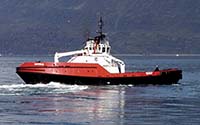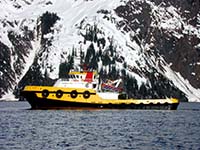By ALAN SORUM
Council Project Manager

A recent council study found that the escort tugs being used in Prince William Sound, though exceedingly capable, no longer represent the best technology being used for these types of applications and services worldwide.
Loaded oil tankers transiting the waters of Prince William Sound are required by federal law and their oil spill contingency plans to be accompanied by two escort tugboats. Currently, escort tugs can serve in a primary or secondary role, depending on performance requirements established in the tanker contingency plans. The goal of the escort tug system is to prevent an oil tanker that suffers a mechanical or propulsion issue from running aground.
These tugboats are part of Alyeska’s Ship Escort/Response Vessel System, or SERVS. In the acronym-laden world of oil shipping and government regulation, SERVS is known as an Oil Spill Response Organization. This is the organization established in the tanker oil spill contingency plan as being responsible for dealing with spill incidents. Tankers under escort by SERVS operate within an approved framework known as the Vessel Escort and Response Plan or VERP. The VERP and the contingency plans detail when and where an escort is conducted. It outlines the role of the primary and secondary tug involved in any escort directed by the organization.

The council has long been concerned with the stated roles of “primary” and “secondary” tugs used by SERVS for escorts. The primary tug is tethered to the laden tanker in Port Valdez, Narrows and Arm and then closely escorts the tanker throughout the rest of its journey out of Prince William Sound. The secondary tug stays within close proximity of the tanker except in central Prince William Sound when a tug may be stationed underway but not necessarily in close continuous proximity to the tanker. While tanker contingency plans make a distinction in the performance of primary and secondary escort tugs, SERVS routinely swaps its more capable tugboats between these two roles.
The most capable tugboats used by SERVS for tanker escorts are found in two classes of vessel, the “Enhanced Tractor Tugs”, or ETT, and “Prevention and Response Tugs”, or PRT. ETTs are propelled by a “Voith Schneider” drive. This type of drive uses a vertical series of blades to direct water in any direction, which makes these tugs very maneuverable. The PRTs use “azimuthing stern drive” propulsion. The propeller in this type of drive is encased in a housing that can rotate in a complete circle, allowing more flexibility in turning than seen with conventional tugs.
Beginning in 2012, the council hired Robert Allan Limited of Vancouver, Canada to compare performance of a worldwide fleet of similar escort-rated tugboats, over 35 meters in length, to the escort tugs used in Prince William Sound. Robert Allan is a highly regarded naval architect known for his innovative work with escort tugboats.
The goal of this study was to determine if the tugs used by SERVS are using the best technology currently available in escort tug design today. Another question focused on the SERVS practice of using the ETT and PRT tugs interchangeably as primary or secondary escort tugs.
The council has taken the stance over the years that the ETT tugs are the only true escort-capable tugs in the SERVS fleet and should be the only vessels used in the primary escort role.
The study found a number of significant gaps in what is considered best available technology for escort tugs today and the SERVS fleet. It noted that neither the ETT nor PRT class of tugboats carries a formal escort notation or rating by a “Classification Society.” Classification societies are non-governmental organizations that establish performance standards and inspection requirements for vessels used in commercial service. The U.S. Coast Guard often defers to class societies to perform vessel inspections and ensure compliance with regulations.
Robert Allan Ltd. pointed out that neither the ETT or PRT tugs are equipped with render-recover tow winches that satisfy class society requirements for an escort notation. A render-recover winch is considered a much safer way to tow a disabled vessel, because it can automatically compensate for changing loads on a towline caused by surging tug hull motions or varying wind and waves.
The study found that the PRT tugs do not have a hull form appropriate for indirect towing, which is a process of simultaneously braking and steering a moving ship, and are limited in their ability to generate the indirect forces necessary to counteract the rudder forces generated by the larger tankers that operate in the Sound.
The report concluded that neither the ETT nor the PRT tugs represent the best technology in use by escort tugs today. In the decade since these vessels were built, technology in hull design and towing equipment has improved dramatically. In their present condition, the ETT class tugs are effective escort tugs that would benefit from installation of a better towing winch system.
The PRT class tugs significantly lack escort towing capability and it would be expensive to change them in a way that would provide this escort capability. That said, there are things that could be done to improve their escort performance. These include installing a render-recover towing winch, relocating a “skeg” on the hull forward, and providing a “towing staple” further back on the tug that could handle higher tow line forces. A towing staple is a device that keeps the towline from moving from side to side on the deck of a tug. Skegs are vertical fins attached to the bottom of a hull that help prevent a boat from moving laterally in the water.
This latest effort by council is one in a series of studies done to improve the tanker escort system used in Prince William Sound and help prevent crude oil from being spilled. While improvements to escort tugs are expensive, the costs are minuscule when compared to the economic and environmental cost of another oil spill in the Sound. World class standards for escort tugs have been established for good cause and should be respected and adopted in Alaska’s crude oil transportation system.
This report is available on this website: A Review of Best Available Technology in Tanker Escort Tugs